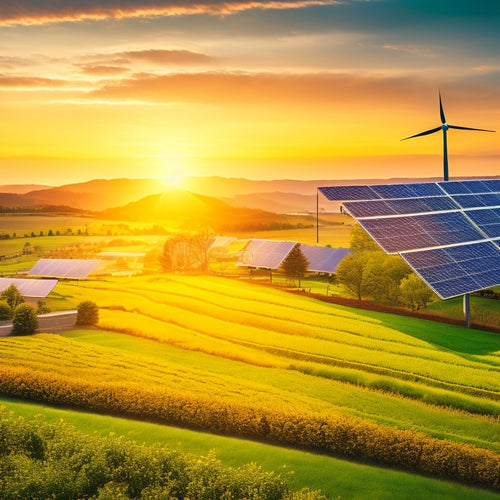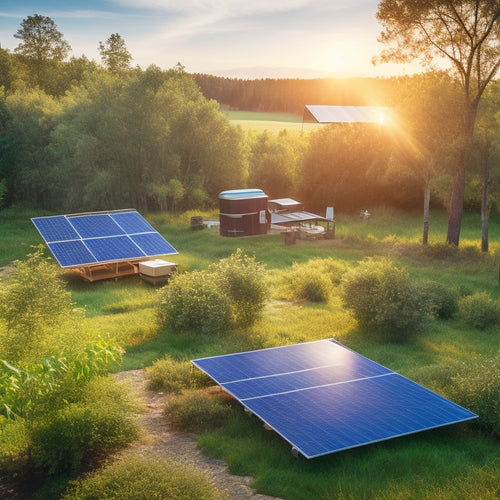
Compact Energy Storage in the Future of Energy
Share
Compact energy storage is at the forefront of the energy change, offering efficient, cost-effective solutions that integrate seamlessly with renewable sources. You'll benefit from advanced technologies like solid-state and lithium-sulfur batteries, which enhance lifespan and reduce expenses. These systems improve grid stability by balancing supply and demand while adapting to your energy needs. They also come with sustainability initiatives, ensuring less waste through recycling. As you investigate these innovations, you'll find out how they're reshaping the energy environment and what opportunities await for maximizing your energy efficiency and independence.
At a Glance
- Compact energy storage solutions enhance grid stability and facilitate the integration of renewable resources, optimizing energy flow and reducing reliance on fossil fuels.
- Advanced battery technologies, such as solid-state and lithium-sulfur batteries, offer improved energy density, lifespan, and sustainability for future energy needs.
- Modular design allows for flexibility and scalability in compact energy storage systems, adapting to varying energy demands and future expansion opportunities.
- Government incentives and subsidies promote investment in compact energy storage, making advanced technologies more accessible and economically viable for consumers and businesses.
- Effective space optimization and thorough location analysis are crucial for the successful installation of compact energy storage systems, maximizing efficiency and adaptability.
Enhanced Efficiency in Storage
As you investigate enhanced efficiency in energy storage, advanced battery technologies play a vital role in improving performance and lifespan.
These innovations, particularly in lithium-ion battery technology, enable higher round-trip efficiency and greater energy density, which are fundamental for effective energy management.
Integrating these technologies with smart grid systems optimizes energy distribution and reduces waste.
Advanced Battery Technologies
The evolution of advanced battery technologies is revolutionizing energy storage, enhancing efficiency and reliability across various applications.
Solid state batteries are leading the charge, offering superior energy density improvements and safety benefits over traditional lithium-ion systems. These innovations, coupled with breakthroughs in lithium sulfur chemistry, promise to markedly extend battery life and reduce costs.
Flow battery advancements are making strides in large-scale energy storage, providing long-duration solutions ideal for renewable sources.
Meanwhile, nanotechnology applications are optimizing electrode materials, allowing for faster charging solutions and improving overall performance.
As you investigate these technologies, consider the importance of sustainability; recycling initiatives are gaining momentum, aiming to minimize waste and enhance resource recovery.
Moreover, environmental impact assessments are becoming vital in evaluating new battery technologies, ensuring that the benefits outweigh potential drawbacks.
Embracing these advancements not only enhances energy independence but also contributes to a cleaner future.
Smart Grid Integration
While integrating smart grid technologies is essential for modern energy systems, it greatly improves the efficiency of energy storage solutions. Smart grids employ advanced communication and automation technologies to optimize energy management, enabling you to utilize stored energy more effectively.
By leveraging real-time data, these systems can predict energy demand and adjust storage operations accordingly, ensuring that you're using energy when it's most cost-effective.
Imagine a scenario where, during peak demand, your energy storage system releases power back to the grid, earning you financial rewards while stabilizing the overall energy network. This interactive relationship not only enhances your energy independence but also helps reduce reliance on fossil fuels, contributing to a greener future.
Moreover, smart grid integration allows for seamless connectivity between various energy sources, including renewable energy systems. You can store excess solar or wind energy and deploy it when necessary, maximizing efficiency and minimizing waste.
This enhanced energy management capability enables you to actively participate in the energy market, giving you the freedom to choose how and when you consume energy. Embracing smart grid technologies isn't just about efficiency; it's about enabling yourself in the energy environment.
Cost-Effective Energy Solutions
As you investigate cost-effective energy solutions, consider how innovative storage technologies can considerably reduce expenses and enhance performance.
Evaluating energy needs for peak battery performance is essential to maximize efficiency and guarantee sustainability.
Government incentives and subsidies further amplify these advancements, making forefront systems more accessible.
Innovative Storage Technologies
Innovative storage technologies are changing the terrain of energy solutions, enabling you to capture and employ renewable resources more efficiently. As the demand for sustainable energy grows, you'll find that advancements like solid state batteries and flywheel energy systems are laying the groundwork for significant improvement in energy storage capabilities.
| Technology Type | Key Features |
|---|---|
| Solid State Batteries | High energy density, safer materials |
| Flywheel Energy | Rapid discharge, long lifespan |
| Supercapacitor Technology | Fast charging, high power output |
Other innovations, such as thermal storage and compressed air systems, are also making waves in the sector. You can now investigate modular systems that adapt to your energy needs, while organic batteries and hybrid systems provide versatile solutions for various applications. Embracing these technologies not only enhances efficiency but also enables you to take control of your energy future. With the right storage options, you can optimize your energy use, reduce costs, and contribute to a greener planet. The future of energy storage is bright, and it's time to tap into these innovative solutions.
Government Incentives and Subsidies
Government incentives and subsidies play an essential role in making energy storage solutions more accessible and cost-effective for consumers and businesses alike. By implementing strong government policies, you can secure financial support that directly impacts your ability to invest in innovative energy storage technologies.
Regulatory structures designed to streamline the approval process for energy projects can create a more favorable investment climate. Tax incentives and energy grants can greatly reduce the upfront costs associated with installing energy storage systems.
These funding programs not only lower your financial barriers but also encourage the adoption of sustainable practices. Additionally, public-private partnerships enhance investment opportunities, allowing you to utilize private capital to expand your energy capabilities.
The economic impact of these incentives is significant, promoting job creation and technological advancement while encouraging sustainability initiatives. As you consider your energy storage options, recognize that maneuvering through these government incentives can lead to more resilient and efficient energy systems.
Key Advantages of Storage Solutions
Storage solutions play an essential role in enhancing grid stability by balancing supply and demand in real-time.
By enabling increased integration of renewable energy sources, you can optimize energy flow and reduce reliance on fossil fuels. These advancements not only strengthen the reliability of the energy system but also pave the way for a sustainable future.
Additionally, efficient battery selection, such as lithium-ion batteries, guarantees homeowners can maximize their energy storage capabilities, further promoting energy independence and resilience.
Enhanced Grid Stability
The grid's resilience benefits greatly from advanced energy storage solutions, which play a critical role in balancing supply and demand. By integrating these storage technologies, you can enhance demand response capabilities, allowing for quick adjustments to fluctuations in energy usage. This means you won't have to rely solely on traditional power plants, which can be slow to react to sudden changes. Instead, energy storage systems can provide immediate support, stabilizing the grid during peak loads or unexpected outages.
Moreover, these solutions contribute greatly to energy resilience, ensuring that you have a reliable power supply even in times of crisis. When unexpected events disrupt the grid, energy storage systems can serve as a buffer, supplying stored energy when it's needed most. This reduces the risk of blackouts and enhances overall system reliability.
The ability to store energy during low-demand periods and release it during high-demand times not only optimizes resource use but enables you to take control of your energy needs.
Ultimately, advanced energy storage solutions pave the way for a more agile, efficient, and resilient energy environment, nurturing a sense of freedom in how you capture and apply energy.
Increased Renewable Integration
Utilizing energy storage solutions greatly enhances the integration of renewable resources into the grid. By effectively managing fluctuations in energy supply and demand, these solutions create a seamless flow of renewable energy, allowing you to tap into the full potential of solar, wind, and other sustainable sources. This renewable collaboration not only maximizes energy generation but also improves overall system reliability.
With energy storage, you can achieve greater energy diversification, reducing dependence on fossil fuels and stabilizing energy prices. When renewable energy production peaks, excess energy gets stored for later use, ensuring you have access even when generation dips. This flexibility enables you to make more informed energy choices, ultimately leading to a cleaner, more sustainable future.
Moreover, the integration of storage solutions encourages innovation in energy management, clearing the path for smart grids that can adapt to real-time needs. You'll experience increased resilience against grid disruptions, all while contributing to a carbon-neutral economy.
Embracing energy storage isn't just a technical upgrade; it's a strategic move toward freedom from traditional energy constraints, aligning with your vision of a sustainable and independent energy environment.
Assessing Your Space Requirements
When evaluating your space requirements for compact energy storage, you need to assess the available area to guarantee ideal installation.
Consider not just your current needs but also future expansion possibilities that could enhance your energy capacity.
Additionally, understanding the key features of energy storage solutions will help you make informed decisions about capacity and power output.
This strategic approach will help you maximize efficiency and adaptability in your energy management.
Evaluating Available Space
Accurately evaluating your space requirements is vital for effective compact energy storage implementation. To start, perform a thorough location analysis to identify the most suitable areas for installation. Consider factors such as accessibility, proximity to energy demand, and existing infrastructure. Each of these elements plays an essential role in optimizing your energy storage system.
Once you've pinpointed potential locations, focus on space optimization. Measure the dimensions and layout of the available area to guarantee it can accommodate the energy storage technology you intend to use, whether that's batteries, flywheels, or supercapacitors.
Analyzing the spatial arrangement helps in maximizing efficiency, allowing you to utilize every square foot effectively.
Future Expansion Considerations
As you evaluate your space requirements, it's essential to think ahead about future expansion. The scalability options of compact energy storage solutions are critical to guarantee you can adapt to market trends and shifting consumer awareness.
When planning, consider not just your current needs but also potential regulatory challenges that may arise as policies shift towards more sustainable practices.
Incorporating an expandable design can mitigate environmental impacts while positioning your system for growth. However, be mindful of technological obstacles that could limit your expansion capabilities.
Stay informed about investment opportunities that may arise from emerging technologies and community engagement initiatives aimed at promoting energy independence.
Furthermore, engaging with local stakeholders can provide perspectives into the changing environment of energy storage. This collaborative approach not only enhances your understanding of the space you'll need but also aligns with broader community goals.
Longer Lifespan Than Competitors
When you evaluate energy storage solutions, consider the enhanced durability features that set our technology apart.
These innovations not only extend the lifespan of the system but also guarantee consistent performance over time.
Enhanced Durability Features
In recent years, advancements in material science have led to the development of compact energy storage solutions with enhanced durability features, greatly extending their lifespan compared to competitors.
These innovations stem from rigorous durability testing that identifies high-performance materials, ensuring superior material resilience.
You'll find that modern manufacturing processes prioritize sustainability, minimizing environmental impact while maximizing efficiency.
By focusing on eco-friendly materials, manufacturers address user feedback regarding the importance of longevity and reduced waste.
Lifecycle analysis plays an essential role in evaluating these energy storage systems.
It allows you to understand the lifespan and maintenance requirements, ensuring that your investment remains viable over time.
Performance benchmarks set by industry standards further validate the durability of these solutions, enabling you to make informed choices.
Frequently Asked Questions
What Types of Compact Energy Storage Systems Are Available Today?
Today, you can investigate various compact energy storage systems like lithium ion batteries and supercapacitor technology. These advanced options offer efficient energy storage solutions, enabling greater freedom in applications ranging from portable devices to renewable energy integration.
How Do Compact Energy Storage Systems Impact Environmental Sustainability?
Compact energy storage systems dramatically shrink your carbon footprint, maximizing resource efficiency like never before. They revolutionize how you utilize energy, promoting environmental sustainability and enabling you to live more freely while protecting our precious planet.
What Are the Maintenance Requirements for These Systems?
You'll need to regularly monitor the system and perform maintenance to guarantee battery longevity. This includes checking connections, updating software, and replacing components as needed, which optimizes performance and enhances overall system reliability and efficiency.
How Do Compact Energy Storage Systems Integrate With Renewable Energy Sources?
You'd think renewable energy stands alone, but it thrives with compact energy storage systems. They enhance grid integration and streamline energy management, ensuring you're utilizing every sunbeam or gust of wind for ultimate freedom.
What Safety Measures Are in Place for Compact Energy Storage Systems?
You'll find that safety measures for compact energy storage systems include fire prevention techniques, advanced thermal management, strict safety standards, strong battery protection, extensive emergency protocols, and continuous system monitoring to guarantee peak performance and user freedom.
Explore More
As you stand on the brink of a new energy era, imagine utilizing compact storage solutions that redefine efficiency. These innovations promise not just cost savings but longevity that outlasts competitors. Visualize your space, optimized and ready to accommodate this advanced technology, revealing a future brimming with potential. What if you could power your life sustainably? The answers are unfolding, and the possibilities are limitless—are you ready to accept the revolution in energy storage?
Related Posts
-

Net Metering in Renewable Energy's Future
Net metering's future is vital for driving renewable energy growth and financial savings. You can reduce your electri...
-

Solar Powered Lights for Sustainable Home Decor
Solar-powered lights offer a stylish and eco-friendly way to enhance your home decor. They capture sunlight, converti...
-

Top Off Grid Solar Batteries for Renewable Energy
When seeking top off-grid solar batteries for renewable energy, consider options with advanced battery chemistry, suc...


